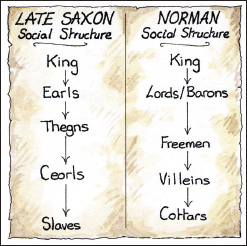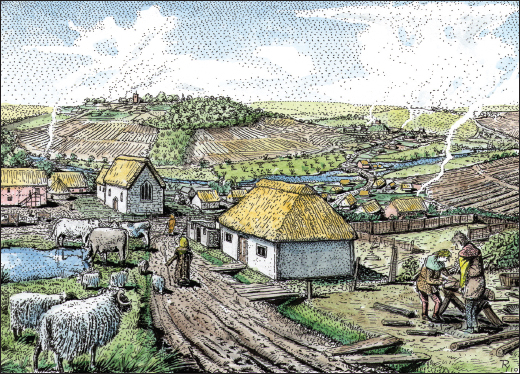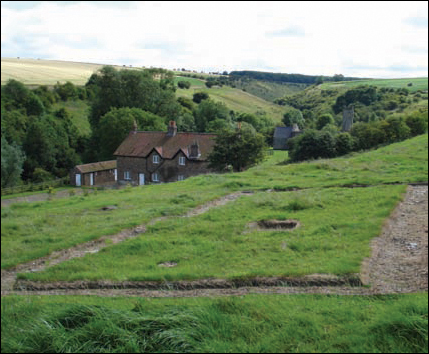The English Village Explained: Britain’s Living History (4 page)
Read The English Village Explained: Britain’s Living History Online
Authors: Trevor Yorke

When the Normans arrived they found, and recorded in the Domesday Book, an ecclesiastical system still in a state of change from the old minsters, which retained some influence especially in the West and North, to one dominated by the parish church. Although there were many local complications, towards the end of the 12th century the process was virtually complete. By now, though, the local lords were losing interest in their churches as a profit-making enterprise. Across Europe this was a time of piety, crusades and pilgrimages and the influence of the Pope was directing the incomes and rights of the Church into the hands of the clergy. New monasteries were established and the wealthy would endow them with land and the upkeep of, and hence profits from, their churches. By 1300 the control of the parish was firmly in the hands of the bishops and monasteries.
During this later Saxon and early medieval period, the people living in the village were, to varying degrees, influenced by what has become known since the 18th century as the feudal system. The basic principle was that the lord or king gave the tenancy of a piece of land (or fee) to an underling who in return gave him military service when called upon. The problem was that
untrained peasants holding pitchforks supplied by the lord of the manor as their part of the bargain were not as effective as mercenaries who didn’t have to return to their fields if the battle clashed with harvest time, so this military service only seems to have been applied effectively in the 11th and 12th centuries. After King John signed the Magna Carta in 1215, recognizing the rights of the barons, it fell from favour, not helped by rebellious subjects who would resist supplying arms for their king even to the extent of barricading themselves in their castles.

FIG 2.9:
A simplified breakdown of many village communities before and after the Conquest
.
At a local level the feudal system varied by region in its structure and in the degrees with which it was applied. In the great swathe of villages across middle England which were surrounded by their two or three large communal fields it was crucial to the smooth running of the agricultural system for the lord to be able to rely on tied peasant labourers. In other areas which maintained the older infield and outfield system like Devon, Essex, and the highland regions, or which were cut out of wastelands in the 12th and 13th centuries as in north Warwickshire, the Fens and parts of the Yorkshire Dales, the feudal system was less influential.
To the peasant this meant he had to not only undertake military service, but also to work his lord’s own demesne (land whose produce was for the direct use of the lord of the manor), give him a quantity of his arable produce and some livestock, perhaps even pay money, and all this on top of his tithe payment to the church. In return he would in theory gain the protection of his lord, the right to appeal for justice to the manor court and the security of knowing his place in this strongly hierarchical society. Although the odds seem stacked against the peasant there were ways of softening the blow of his obligations. For instance, he might send a less able or lazy member of the family to work the lord’s land or give him only his poorest livestock.
It is misleading, however, to refer to all those who laboured on the land as peasants, for there were many levels of status within this broad band. The categories varied over time and region but by the 12th and 13th centuries the following groupings were the most prominent. Below the lord of the manor was a freeman or franklin who was, as the name suggests, someone who was free of obligations of service to the lord. He would still have to do some jobs, perhaps supervise at harvesting, or he might be the miller, but in general he paid a rent for his land and could therefore invest money back into his holding. Next down the ladder was the largest group – the villeins, who tenanted scattered strips of land by performing duties which have been previously described. Within this band were specialist workers like the blacksmith, the reeve (who was responsible for collecting rent), and even the priest of a poorer parish. At the bottom were cottars, who were judged on their smallholding of land or worst of all, if they tenanted land from one of their neighbours rather than the lord. This group could include those who did the ploughing and herding on the demesne land or looked after the lord’s wood and grain.
The village as a community would agree at regular meetings which crops should be grown in which field and at what time; the inevitable disagreements and disputes would be heard at the Manor Court and some of the records (or court rolls) still exist. It would also be part of a hundred or wapentake, a subdivision of a shire, which was taking shape in the early 11th century. Each hundred would have its own court where the freemen from the villages would meet to resolve local disputes and matters of law and order. In 1279, Edward I ordered a survey of villages to ascertain who held which land within each hundred. Known as the Hundred Rolls, it was more comprehensive than the Domesday Book but, unfortunately, the returns for only five counties survive.

FIG 2.10 EXEMPLAR VILLAGE c.1200:
In our first trip to this imaginary village, new houses are being built in the foreground around a green which will hold regular markets, a development planned by the lord of the manor whose house stands in the background next to the church his predecessors had erected to serve the old estate. This village will continue to grow through the next century. However, the population was unlikely to foresee the cracks that were already appearing in the rapidly overstretched agricultural system, the approaching storm clouds that would savagely open them up and the plague that would decimate their families. The story of these events and the resulting decline of villages like this will unfold in the next chapter
.
HAPTER
3
 | Declining Fortunes |  |

FIG 3.1:
The later Middle Ages were a time of great contrasts, as in this view with larger houses and a new tower on the church paid for by the successful members of the community but with abandoned and rundown plots in the foreground. What were the events that caused this and how did it shape villages during this period?
T
he storm clouds which were gathering finally broke over England in the early 14th century. Firstly there was a climatic downturn, often referred to as the Little Ice Age, which was to last until the 17th century, producing bitter, cold winters and wet, ruinous summers.
Harvests were poor and widespread famine affected the country, particularly between 1315 and 1317. Yet worse was to come as rats from Asia which carried fleas infected with bubonic plague spread the disease across Europe, entering England from the south coast in the summer of 1348. By December of the following year it is estimated to have claimed the lives of between a third and a half of the population. It did not matter if you were rich or poor, the appearance of small black buboes on your body (hence the ‘Black Death’, the common name for this first outbreak) meant you probably had only days to live. The plague revisited these shores numerous times over the following three centuries, and the population did not begin to grow again until the 1500s. The fear and foreboding the plague created can be seen in the monuments, tombs and church carvings of the period.

FIG 3.2 ASHWELL CHURCH, HERTS:
Incredibly, this graffiti carved into the soft stone on the inside of the church tower was scrawled in the aftermath of the Black Death. Part of the Latin text shown here translates as ‘… pitiable fierce violent (plague departed)’ and ‘… a wretched populace survives to witness…’, relating to the plague and the survivors witnessing a terrible storm which struck in 1361
.
The worsening climate in the early 14th century first affected those forced to farm marginal lands like upland areas and moors where the weak, thin soils would have struggled to support a good crop even in better weather, and now they were abandoned. The Black Death had an even more devastating effect as it left the great open fields around the village only partly farmed. The lord of the manor, anxious to maintain the income from his estate, would have encouraged those who survived the epidemic to work their neighbours’ land rather than see it idle and unproductive. Others may have decided it was best to lease or even sell their land to ambitious villagers, who began to form a new rank of yeoman farmer.
These changes in land ownership started to alter the physical appearance of the countryside as the old common fields and wastes were divided up into enclosed blocks of land held by one farmer. This form of enclosure by agreement usually occurred where there had been such a loss of life or so many people had moved away that the land could be easily divided between the few remaining villagers. They would firstly have to group their holdings together as their arable strips were scattered at random around the open fields, then
once they had bought and exchanged these between them, the new farmers could set about enclosing their consolidated holdings.
Such early enclosures seem to have occurred mainly in the west and north, in counties like Herefordshire, Shropshire, Cheshire and Lancashire, and also in parts of Suffolk, Essex and Kent. Where the common system of open fields was dominant, especially in the Midlands and up into Yorkshire, enclosure at this date is rare; the new farmers bought up abandoned strips but continued to farm as a community. It would have been too complicated, especially if the village was well populated, to enclose the fields by all parties reaching agreement. There were some exceptions. For instance, when a farmer wanted to grow a different crop from the surrounding one in the open field, he could fence in his strip, leaving long, thin fields which you can still identify today.
In the 15th century many landowners decided to change from arable farming to rearing livestock, especially sheep, due to its low labour cost and the rising price of wool and cloth. A greater profit could be achieved by clearing the land of houses and their crofts, enclosing the fields and turning them over to pasture. These attempts to remove villages and enclose common land brought much protest, especially in the Midlands, though it often still went ahead despite legislation, investigations and commissions. It also seems to have been prevalent in the wastes in the North and areas like Gloucestershire where sheep farming had always been an important part of the local economy.
The Black Death is often credited as the cause of the desertion of many villages in this period. However, it is more likely that although disease directly claimed a few, it was the combination of this and other factors over a longer period which weakened them and finally resulted in abandonment often in the late 14th or 15th century. Today, so far, some
3,000 deserted medieval villages have been identified.

FIG 3.3:
A diagram showing how a planned village could, with the abandonment of plots in the 14th century (cream-coloured in the centre map) and their adoption by neighbours, lose its original regular layout
.
Whether a settlement survived this period of despair could depend on its size and population. A larger village which maintained a good number of residents would show signs of decline in the form of abandoned houses and plots of land between those which were still occupied. Over a period of time these may have been re-occupied by a neighbour, and in this way parts of a village with a 12th- or 13th-century planned layout became irregular with a mixture of different sized plots. The smaller, less populated settlements were more likely to become deserted. This could be a gradual process spanning in some cases 500 or 600 years until the final resident departed, in others the remaining population was simply uprooted and replaced by a single farmer or shepherd.
As in previous periods there was a surprising amount of settlement mobility. Some villages may have drifted away from an area prone to flooding now the climate had deteriorated, or they moved onto better land which had been abandoned. In other cases whole villages were relocated to a nearby site, often due to the actions of the landlord especially when introducing large-scale sheep farming. And, despite the decline in population, villages were still being established – some may have appeared near a new industrial area. Many coastal fishing villages were founded in the period, whilst woodland was still being cleared in areas like Warwickshire and new settlements formed.

FIG 3.4 WHARRAM PERCY, YORKS:
Where there has been no later ploughing of the land upon which a deserted medieval village stood then it can often be identified on the ground. With the general build up of waste and the regular rebuilding of cottages, the platform on which they stood would rise and can still be seen today above the surrounding land. The roads and tracks which ran between them were usually lower as the constant wear, rainfall and the removal of manure from its surface would have left them hollowed out. Wharram Percy in Yorkshire is a notable example, pictured here with the footings of a longhouse exposed. The shell of its church stands in a hollow surrounded by grassed-over platforms and winding roads. Where the land on which these villages stood is now under the plough, then the only trace may be pieces of broken pottery which have been turned up by the farmer. Systematically walking across fields (field-walking) can identify areas of intense debris and hence relocate these lost settlements
.
With the new opportunities in farming and trade, entrepreneurial individuals like merchants could make themselves a fortune. In previous centuries people in this position would have granted land to monasteries in order to assure themselves of a safe passage to Heaven. Now, however, they were more likely to direct their funds to their parish church, building new towers, chantry chapels and establishing collegiate churches. In areas of the country dominated by sheep, completely new or enlarged churches appeared embellished in the latest Perpendicular architectural fashion. Referred to as ‘wool churches’, they are a notable feature of areas like the Cotswolds, but reached their zenith in East Anglia where stunning edifices often ablaze with stained-glass seem like oversized ego trips which the entire village population would have struggled to fill.
